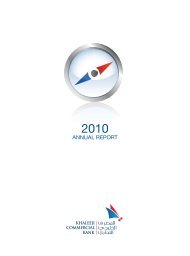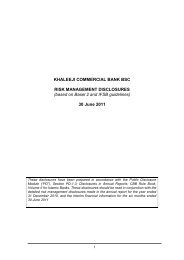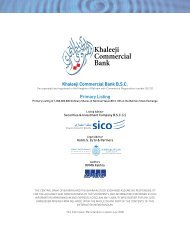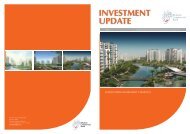2011 Annual Report - Khaleeji Commercial Bank BSC
2011 Annual Report - Khaleeji Commercial Bank BSC
2011 Annual Report - Khaleeji Commercial Bank BSC
Create successful ePaper yourself
Turn your PDF publications into a flip-book with our unique Google optimized e-Paper software.
KHALEEJI COMMERCIAL BANK <strong>BSC</strong><br />
NOTES TO THE CONSOLIDATED FINANCIAL STATEMENTS<br />
for the year ended 31 December <strong>2011</strong><br />
31. RISK MANAGEMENT (continued)<br />
OPERATIONAL RISK (continued)<br />
The <strong>Bank</strong> has completed conducting one cycle of Risk Control Self-Assessment (RCSA) of Operational risk for majority of<br />
the departments of the <strong>Bank</strong> to identify the important Key Risk Areas, Key Risk Indicators and Key Risk Triggers: the RCSA<br />
process is a continuous process and will be conducted at regular frequencies across the <strong>Bank</strong>. A software for monitoring these<br />
triggers and recording actual and near miss losses is already in place. The medium term objective of the <strong>Bank</strong> is to generate<br />
statistically reliable data to upgrade to more sophisticated modes of Operational Risk Control both to manage the risk better<br />
and to reduce capital commitment.<br />
CAPITAL MANAGEMENT<br />
The Central <strong>Bank</strong> of Bahrain (CBB), sets and monitors capital requirements for the <strong>Bank</strong> as a whole. In implementing current<br />
capital requirements CBB requires the <strong>Bank</strong> to maintain a prescribed ratio of total capital to total risk-weighted assets. Capital<br />
adequacy regulations of CBB is based on the principles of Basel II of the IFSB guidelines.<br />
The <strong>Bank</strong>’s regulatory capital is analysed into two tiers:<br />
• Tier 1 capital, includes ordinary share capital, disclosed reserves including share premium, general reserves, legal / statutory<br />
reserve as well as retained earnings after deductions for goodwill and other regulatory adjustments relating to items that<br />
are included in equity but are treated differently for capital adequacy purposes. As on 31 December <strong>2011</strong>, the deductions<br />
to Tier 1 were Nil.<br />
• Tier 2 capital, includes interim retained profits reviewed by the auditors and an allowed portion profit equalisation reserve<br />
(PER) and investment risk reserves (IRR). As per CBB, the PER & IRR can be up to a maximum amount equal to the capital<br />
charge pertaining to 30% of the risk weighted assets financed by equity of investment account holders.<br />
Certain limits are applied to elements of the capital base in line with regulatory requirements. Tier 1 capital should represent at<br />
least half of the total eligible capital, i.e. Tier 2 capital is limited to 100% of Tier 1 capital. The limit on Tier 2 capital is based on the<br />
amount of Tier 1 capital after all deductions of investments pursuant to Prudential Consolidation and Deduction Requirements<br />
(PCD) Module of the CBB. The PCD Module sets out the regulatory rules for prudential consolidation, pro-rata consolidation<br />
or deduction where the own controlling or significant minority stakes in regulated financial entities, insurance entities and have<br />
significant exposures to investment in commercial entities. It also sets out the framework for the prudential deductions from<br />
capital for various instances including exposures to counterparties exceeding the large exposure limits as set out by CBB. As on<br />
31 December <strong>2011</strong>, the <strong>Bank</strong> was not required to make any deductions under the requirements of the PCD Module.<br />
<strong>Bank</strong>ing operations are categorised as either trading book or banking book, and risk-weighted assets are determined according<br />
to specified requirements that seek to reflect the varying levels of risk attached to assets and off-balance sheet exposures.<br />
For computation of credit risk on assets financed by equity of investment account holders, 30% of risk weight assets are<br />
considered as against 100% for assets self-financed.<br />
The <strong>Bank</strong>’s policy is to maintain a strong capital base so as to maintain investor, creditor and market confidence and to sustain<br />
future development of the business. The impact of the level of capital on shareholders’ return is also recognised and the <strong>Bank</strong><br />
recognises the need to maintain a balance between the higher returns that might be possible with greater gearing and the<br />
advantages and security afforded by a sound capital position.<br />
The <strong>Bank</strong> has adopted the standardised approach to credit and basic indicator approach for management of operational risk<br />
under the CBB capital adequacy framework. The <strong>Bank</strong> on a conservative basis for capital management does not claim any of<br />
the benefits for permissible credit risk mitigants against credit exposure.<br />
Consolidated Financial Statements<br />
77










